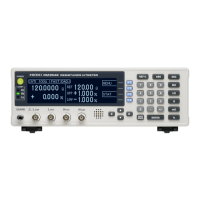9.5 Communication Methods
107
9
Separators
(1) Message Unit Separator
Multiple message can be written in one line by separating them with semicolons “;”
• When messages are combined in this way and if one command contains an error, all sub-
sequent messages up to the next terminator will be ignored.
• A query error occurs if a query command is combined with an immediately following semi-
colon and subsequent command.
(2) Header Separator
In a message consisting of both a header and data, the header is separated from the data by
a space “ ” (ASCII code 20H).
(3) Data Separator
In a message containing multiple data items, commas are required to separate the data items
from one another.
Data Formats
The instrument uses character data and decimal numeric data, depending on the command.
(1) Character Data
Character data always begins with an alphabetic character, and subsequent characters may
be either alphabetic or numeric. Character data is not case-sensitive, although response
messages from the instrument are only upper case.
(2) Decimal Numeric Data
Three formats are used for numeric data, identified as NR1, NR2 and NR3. Numeric values
may be signed or unsigned. Unsigned numeric values are handled as positive values.
Values exceeding the precision handled by the instrument are rounded to the nearest valid
digit.
•
NR1 Integer data (e.g.: +12, -23, 34)
• NR2 Fixed-point data (e.g.: +1.23, -23.45, 3.456)
• NR3 Floating-point exponential representation data (e.g.: +1.0E-2, -2.3E+4)
The term “NRf format” includes all three of the above numeric decimal formats.
The instrument accepts NRf format data.
The format of response data is specified for each command, and the data is sent in that for-
mat.
:ESE0 106
:FETCH?
+106.571
The instrument does not fully support IEEE 488.2. As much as possible, please use the data
formats shown in the Reference section.
Also, be careful to avoid constructing single commands that could overflow the input buffer or
output queue.
:SYSTEM:LFREQUENCY 60;IDN?
:CALCULATE:LIMIT:ABS 1.00035,0.99965

